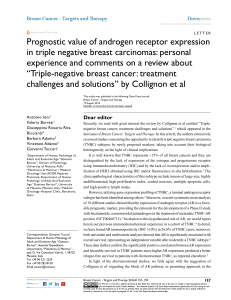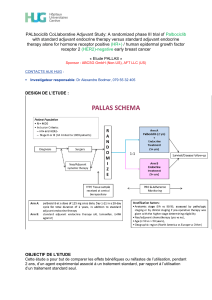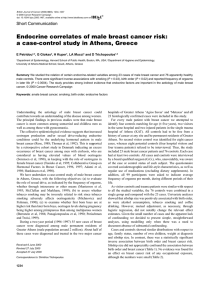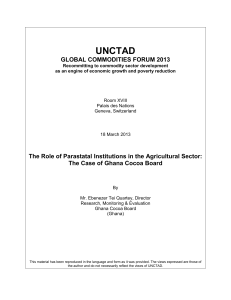Triple-Negative Breast Cancer among Ghanaian Women Seen at Korle-Bu Teaching Hospital ASHDIN
publicité
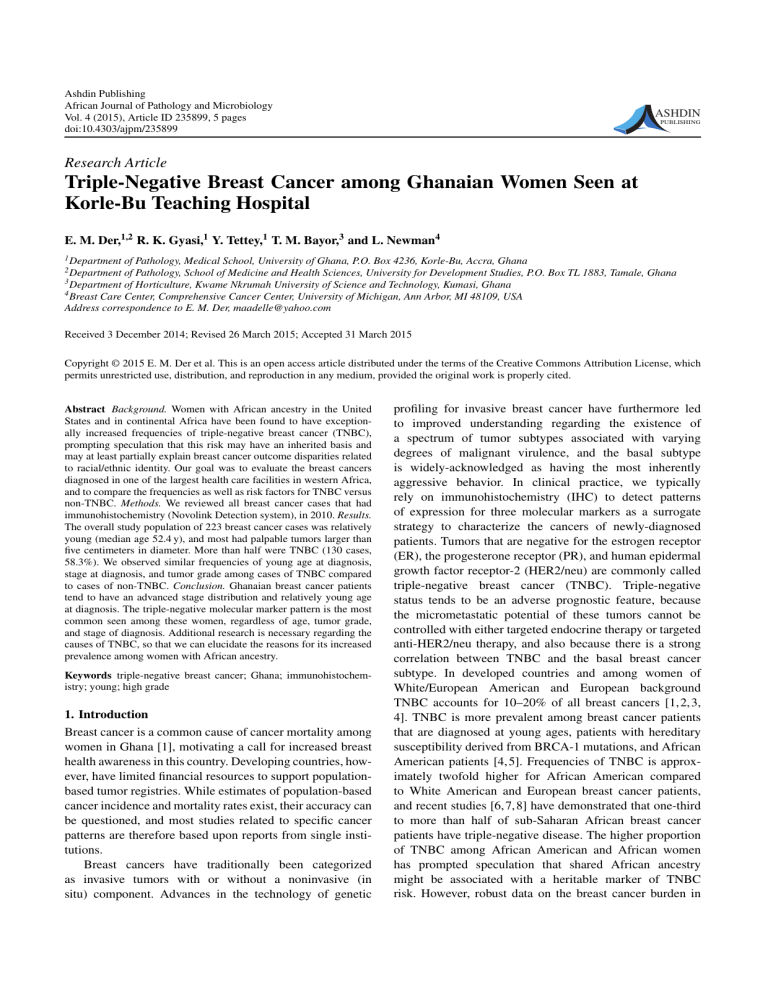
Ashdin Publishing African Journal of Pathology and Microbiology Vol. 4 (2015), Article ID 235899, 5 pages doi:10.4303/ajpm/235899 ASHDIN publishing Research Article Triple-Negative Breast Cancer among Ghanaian Women Seen at Korle-Bu Teaching Hospital E. M. Der,1,2 R. K. Gyasi,1 Y. Tettey,1 T. M. Bayor,3 and L. Newman4 1 Department of Pathology, Medical School, University of Ghana, P.O. Box 4236, Korle-Bu, Accra, Ghana of Pathology, School of Medicine and Health Sciences, University for Development Studies, P.O. Box TL 1883, Tamale, Ghana 3 Department of Horticulture, Kwame Nkrumah University of Science and Technology, Kumasi, Ghana 4 Breast Care Center, Comprehensive Cancer Center, University of Michigan, Ann Arbor, MI 48109, USA Address correspondence to E. M. Der, [email protected] 2 Department Received 3 December 2014; Revised 26 March 2015; Accepted 31 March 2015 Copyright © 2015 E. M. Der et al. This is an open access article distributed under the terms of the Creative Commons Attribution License, which permits unrestricted use, distribution, and reproduction in any medium, provided the original work is properly cited. Abstract Background. Women with African ancestry in the United States and in continental Africa have been found to have exceptionally increased frequencies of triple-negative breast cancer (TNBC), prompting speculation that this risk may have an inherited basis and may at least partially explain breast cancer outcome disparities related to racial/ethnic identity. Our goal was to evaluate the breast cancers diagnosed in one of the largest health care facilities in western Africa, and to compare the frequencies as well as risk factors for TNBC versus non-TNBC. Methods. We reviewed all breast cancer cases that had immunohistochemistry (Novolink Detection system), in 2010. Results. The overall study population of 223 breast cancer cases was relatively young (median age 52.4 y), and most had palpable tumors larger than five centimeters in diameter. More than half were TNBC (130 cases, 58.3%). We observed similar frequencies of young age at diagnosis, stage at diagnosis, and tumor grade among cases of TNBC compared to cases of non-TNBC. Conclusion. Ghanaian breast cancer patients tend to have an advanced stage distribution and relatively young age at diagnosis. The triple-negative molecular marker pattern is the most common seen among these women, regardless of age, tumor grade, and stage of diagnosis. Additional research is necessary regarding the causes of TNBC, so that we can elucidate the reasons for its increased prevalence among women with African ancestry. Keywords triple-negative breast cancer; Ghana; immunohistochemistry; young; high grade 1. Introduction Breast cancer is a common cause of cancer mortality among women in Ghana [1], motivating a call for increased breast health awareness in this country. Developing countries, however, have limited financial resources to support populationbased tumor registries. While estimates of population-based cancer incidence and mortality rates exist, their accuracy can be questioned, and most studies related to specific cancer patterns are therefore based upon reports from single institutions. Breast cancers have traditionally been categorized as invasive tumors with or without a noninvasive (in situ) component. Advances in the technology of genetic profiling for invasive breast cancer have furthermore led to improved understanding regarding the existence of a spectrum of tumor subtypes associated with varying degrees of malignant virulence, and the basal subtype is widely-acknowledged as having the most inherently aggressive behavior. In clinical practice, we typically rely on immunohistochemistry (IHC) to detect patterns of expression for three molecular markers as a surrogate strategy to characterize the cancers of newly-diagnosed patients. Tumors that are negative for the estrogen receptor (ER), the progesterone receptor (PR), and human epidermal growth factor receptor-2 (HER2/neu) are commonly called triple-negative breast cancer (TNBC). Triple-negative status tends to be an adverse prognostic feature, because the micrometastatic potential of these tumors cannot be controlled with either targeted endocrine therapy or targeted anti-HER2/neu therapy, and also because there is a strong correlation between TNBC and the basal breast cancer subtype. In developed countries and among women of White/European American and European background TNBC accounts for 10–20% of all breast cancers [1, 2, 3, 4]. TNBC is more prevalent among breast cancer patients that are diagnosed at young ages, patients with hereditary susceptibility derived from BRCA-1 mutations, and African American patients [4, 5]. Frequencies of TNBC is approximately twofold higher for African American compared to White American and European breast cancer patients, and recent studies [6, 7, 8] have demonstrated that one-third to more than half of sub-Saharan African breast cancer patients have triple-negative disease. The higher proportion of TNBC among African American and African women has prompted speculation that shared African ancestry might be associated with a heritable marker of TNBC risk. However, robust data on the breast cancer burden in 2 African Journal of Pathology and Microbiology Table 1: Clinical characteristics of breast cancers from Korle Bu Teaching Hospital 2010, total sample (223 cases). Table 2: Histological characteristics of breast cancers that had IHC conducted. Number (n) Frequency (n) Percentage (%) ≤ 39 41 18.4 40–49 56 25.1 Age/y 50–59 56 25.1 60–69 38 17.0 70+ 32 14.4 Total 223 100.0 2.0 22 25.6 Size of lump (cm) 2.5–5.0 38 44.2 26 30.2 ≤ 5.5 Total 86 100.0 Skin involvement 22 61.1 Chest wall 2 5.6 Other associated symptoms Nipple discharge 4 11.1 Others 8 22.3 Total 36 100.0 ≤ 16 33 49.3 17–32 12 17.9 Duration of symptoms (w) 33–52 13 19.4 > 52 9 13.4 Total 67 100.0 Needle biopsy 95 42.6 Type of surgical Mastectomy 68 30.5 specimen analyzed Lumpectomy 52 23.3 Incisions biopsy 8 3.6 Total 223 100.0 Variant Number (n) Percentage (%) IDC-NOS 169 75.8 Lobular 12 5.4 Mucinous 9 4.0 Cribriform 7 3.1 Micropapillary 6 2.7 Medullary 4 1.8 DCIS 7 3.1 Others 9 4.0 Total 223 100.0 Grade I 20 17.2 Grade II 46 39.7 Grade III 50 43.1 Total 116 100.0 Single 8 25.8 Multiple 23 74.2 Total 31 100.0 Stage I-II 11 44.0 Stage III-IV 14 66.0 Total 25 100.0 TNBC 130 58.3 HR−/HER2+ 52 23.3 HR+/HER2− 18 8.1 HR+/HER2+ 23 10.3 Total 223 100.0 Clinical feature Africa are lacking because the limited healthcare workforce and pathology infrastructure in most facilities precludes routine IHC testing as well as epidemiologic studies. This limitation makes it difficult to ascertain whether the higher frequency of TNBC reported in African populations is a real phenomenon related to some intrinsic, inherited susceptibility or a spurious finding. Our goal was to evaluate the clinicopathologic patterns of TNBC observed in one of the most prominent hospitals in sub-Saharan Africa, and to correlate these patterns with standard breast cancer features. 2. Materials and methods The Korle Bu Teaching Hospital is affiliated with the University of Ghana and is located in Accra, the capital of Ghana. We retrospectively reviewed all cases of histologically confirmed breast cancers for which IHC analyses of ER, PR, and HER2/neu were conducted in the Korle Bu department of pathology during the year 2010. For each case, the patient age, clinical characteristics of the breast cancer, histologic findings, TNM stage, and the molecular marker profile were recorded. IHC was performed on sections from formalin-fixed, paraffin-embedded specimens using Novolink Detection system (brand name; Novocastra) manufactured by Leica Microsystems GmbH. Cases were scored as being ER or PR positive if at least 10% nuclear staining was observed. They were scored as being Histologic type Histologic grade Nodal positive TNM stage IHC profile HER2/neu positive if complete membranous staining was observed in 10% or more cells. These data were entered into SPSS microcomputer software version 18 (Chicago), and analyzed. The results were presented in frequency tables. Comparisons of triple-negative and nontriple-negative breast cancers were conducted using Spearman’s correlation coefficient. Histologic grade of tumors was based on the architectural and cytologic features of the tumor; the grade was according to the modified Scarff-Bloom-Richardson grading system and the TNM staging was that used by the American Joint Committee on Cancer (AJCC). 3. Results A total of 223 breast cancer cases were identified. Clinicopathologic characteristics of this study sample are shown in Table 1. The ages ranged from 25 through 90 years with a mean of 52.4 (SD = 13.6) y. The majority of cases (61%) presented with palpable breast masses associated with skin changes/involvement. Mean tumor size was 4.5 cm, with a range of 0.5–14 cm. Information on duration of breast symptoms/palpable disease prior to biopsy was available for 67 patients, and the mean time of 35 w (range of 1–53 w). Histopathologic characteristics and IHC were assessed from core needle biopsy specimens in 95 cases (42.6%) versus lumpectomy and mastectomy specimens in 19.3% and 34.6% of cases, respectively. As shown in Table 2, African Journal of Pathology and Microbiology 3 Table 3: Comparison of triple-negative and nontriple-negative breast cancers at the Korle-Bu Teaching Hospital in 2010. Feature Age < 40 ya Age 40–49 y Age ≥ 50 y Tumor ≤ 2 cma Tumor > 2 cm, ≤ 5 cm Tumor > 5 cm Skin involvementa Grade III histologya AJCC stage 1 AJCC stage 2 AJCC stage 3 AJCC stage 4 AJCC stage 1 to 2 AJCC stage 3 to 4 Invasive ductal histologya Invasive lobular histology Node positivea a Total TNBC N = 130 N (%) 23 (17.1%) 34 (26.2%) 73 (56.1%) 8 (16.3%) 22 (44.9%) 19 (38.8%) 11 (61.1%) 33 (47.1%) 1 (6.2%) 5 (31.2%) 3 (18.8%) 7 (43.8%) 6 (37.5%) 10 (62.5%) 89 (87.1%) 2 (1.9%) 20 (44.4%) Non-TNBC N = 93 N (%) 18 (19.4%) 22 (23.7%) 35 (56.9%) 14 (37.8%) 16 (43.2%) 7 (19.0%) 10 (61.1%) 17 (37.0%) 0 (0.0%) 6 (60.0%) 1 (10.0%) 3 (30.0%) 6 (60.0%) 4 (40.0%) 62 (86.1%) 6 (8.3%) 11 (47.8%) P value (comparing proportion of TNBC expressing the selected feature with the proportion of non-TNBC cases expressing the selected feature) 0.774 0.369 0.513 0.327 0.324 0.153 0.500 0.142 0.398 0.478 0.358 0.320 0.500 0.334 0.476 0.144 0.730 number of TNBC and non-TNBC cases do not add up to 223 because of missing data on selected patients. the majority of cancers (169, 75.8%) were invasive ductal carcinoma, not otherwise specified (IDC-NOS) histology and 12 (5.4%) were invasive lobular, 7 (3.1%) were DCIS, and the remaining 12% were various unusual breast cancer patterns (e.g., mucinous, micropapillary, and neuroendocrine). Nearly half of 113 cases for which tumor grade was available (50 cases, 43.1%) were grade 3 lesions. Complete clinicopathologic staging was available for only 25 cases and of these, two-thirds (14 cases, 66%) were stage III or IV disease. Regional nodal staging information was only available to a limited extent on the 68 patients that underwent mastectomy, and of these cases there was unfortunately limited documentation regarding the anatomic extent of the axillary dissection. However, of these cases, 31 (45.6%) were node-positive, and the majority of these node-positive cases (23/31, 74%) had multiple metastatic nodes, with a mean of five positive nodes (range of 1–28). One hundred and thirty (58.3%) of the 223 cases were TNBC and another one-quarter (52, 23.3%) were negative for ER and PR but positive for HER2/neu. Only 41 (18%) were positive for ER and/or PR, and among these hormone receptor-positive tumors more than half (23/41, 56%) were HER2/neu-positive. Age range for the 130 TNBC cases was 25–90 y, with a mean of 51.7 (SD 13.3) y; while the range for the 93 non-TNBC cases was 25–84 y, with mean age 52.9 (SD 14.2) y. Mean size for the TNBC tumors was 5.1 cm (range of 1–14 cm), and patients reported the presence of a palpable mass that was present for 1–156 w (mean 37 w). A comparison of the TNBC and non-TNBC tumors is shown in Table 3. No significant differences were observed between these subsets in distribution by age, histology, stage, or tumor grade. 4. Discussion Breast cancer is well-known as a lower-burden disease in developing countries of Asia and Africa compared to western, industrialized areas of the world such as North America and Europe. Financial resources to support accurate and updated statistics are limited, but recent estimates report incidence rates of 15–53 per 100,000 women in western, sub-Saharan Africa [19]. By comparison, population-based incidence rates in the United States are 125 and 116 per 100,000 White American and African American women, respectively [20]. Historically, this difference in breast cancer burden has largely been attributed to variation in reproductive history risk factors, such as age at first live birth and number of pregnancies. Women in developing countries typically begin childbearing at relatively young ages and they have multiple pregnancies, which would account for a lower population-based breast cancer burden. At least two lines of evidence have generated speculation that hereditary factors may also be contributing to the patterns of breast cancer observed in women from the developing countries of western, sub-Saharan Africa: (i) similarities in the breast cancer burden of western, sub-Saharan Africans, and African Americans, who would be expected to have a significant degree of shared ancestry dating back to the colonial slave trade. Both of these populations have a lower lifetime risk of female breast cancer, yet they face a higher risk of early-onset disease, and an increased risk of male breast cancer. These same patterns are characteristically seen 4 African Journal of Pathology and Microbiology Table 4: Selected studies reporting frequency of triple-negative breast cancer in African nations compared to other developing countries. Study Trinkaus et al. [9] Gakinya et al. [10] Bird et al. [7] Roy and Othieno [8] Country Kenya Kenya Kenya Uganda Region of Africa East Africa East Africa East Africa Southern, sub-Saharan Africa Huo et al. [11] Nigeria and Senegal Western, sub-Saharan Africa Stark et al. [6] Awadelkarim et al. [12] Abdelkrim et al. [13] Ambroise et al. [14] Teoh et al. [15] Tan et al. [16] Ghosh et al. [17] Ng et al. [18] Ghana Sudan Tunisia India Malaysia Malaysia India Indonesia Western, sub-Saharan Africa Northern Africa Northern Africa South Asia Southeast Asia Southeast Asia South Asia Southeast Asia in families with documented hereditary susceptibility for BRCA1 mutation-associated breast cancer; (ii) advances in the understanding of breast cancer subtypes have led to an appreciation for particular disease patterns that have different risk factors as well as inherent virulence. TNBC (tumors that lack expression of ER, PR, and HER2/neu) are biologically more aggressive lesions because they are resistant to targeted endocrine and anti-HER2/neu therapies, and also because they are more likely to belong to the biologically more aggressive basal breast cancer subtype. TNBC is now considered to be a hallmark of inherited susceptibility for breast cancer, prompting a genetic counseling referral when detected in women up to the age of 50 y [21]. TNBC is more common in African American compared to White American women, and as shown in Table 4, frequency of triple-negative breast cancer is also higher in women of western, sub-Saharan Africa compared to those of other developing countries, suggesting that African ancestry may be the common denominator link to TNBC risk. While parallels in the breast cancer burden of African American and African women are provocative and suggestive of heritable risk, the paucity of tumor registry and molecular marker information in Africa makes it difficult to draw definitive conclusions. Additional data characterizing the breast cancer burden of African women is therefore necessary. The scarcity of financial resources to support maintenance of basic pathology services and IHC facilities for routine molecular marker assessment in Ghana prompts the question of whether the absence of ER, PR, and HER2 staining might simply reflect suboptimal tissue processing with universal antigen decay. However, other studies have demonstrated increased expression of other molecular markers in African populations, such as cytokeratins (which Frequency of TNBC 32% 23% 44% 36% 27% (proportion of cases that were TNBC and cytokeratin-positive) 82% 15.9% 18% 25% 15% 17.6% 29.8% 21% are associated with the inherently aggressive basal-TNBC subtype) [11, 22], and ALDH1 (a mammary stem cell marker) [23]. Ghana is located in western, sub-Saharan Africa. Accra is the capital of Ghana, and its Korle Bu Teaching Hospital, affiliated with the University of Ghana, is one of the few facilities where breast cancer specimens are routinely referred for IHC to assess ER, PR, and HER2/neu expressions. In this study of 223 breast cancer cases that had IHC for hormone receptor and human epidermal growth factor (ER, PR, and HER2-neu), the majority of cases (58.3%) were triple-negative tumors. While studies of TNBC in North America and Europe have consistently demonstrated an association between TNBC and young age at breast cancer diagnosis [3, 4, 24], our study revealed a similar prevalence of TNBC among Ghanaian breast cancer patients in all age categories. Similarly, at least one population-based study from California has demonstrated an increased risk of TNBC among African American compared to White American women in the fourth, fifth, sixth, and seventh decades of age [25]. These observations suggest that African ancestry may be associated with some heritable pattern of mammary tissue that is more susceptible to the development of TNBC in both the pre- and post-menopausal age categories. 5. Conclusion Triple-negative breast cancer is the common pattern of invasive breast cancer seen among Ghanaian women, based upon our retrospective review of cases evaluated at one of the largest hospitals in western Africa during a recent one-year period. Presentation for all breast cancers from this region tends to be late with most cases characterized by large/palpable, node-positive, and high grade tumors. Increased breast health awareness and improved access to health care in Africa may strengthen early detection efforts. However, the increased prevalence of TNBC among African Journal of Pathology and Microbiology 5 Ghanaian breast cancer patients of all ages suggests that research regarding the genetics of breast cancer related to African ancestry warrants further study. Acknowledgments The authors wish to express their sincere gratitude to the technical staff, especially, Miss Nahima (data collection) and Mr. Andrews (immunostaining) of the histology department. They also thank colleagues, residents and specialists in the department for their support. Finally, the first author personally wishes to acknowledge the Ghana-Michigan PARTNER Program. [16] [17] References [1] R. Ismail-Khan and M. M. Bui, A review of triple-negative breast cancer, Cancer Control, 17 (2010), 173–176. [2] L. Carey, C. Perou, C. Livasy, L. Dressler, D. Cowan, K. Conway, et al., Race, breast cancer subtypes, and survival in the Carolina Breast Cancer Study, JAMA, 295 (2006), 2492–2502. [3] R. Dent, M. Trudeau, K. I. Pritchard, W. M. Hanna, H. K. Kahn, C. A. Sawka, et al., Triple-negative breast cancer: clinical features and patterns of recurrence, Clin Cancer Res, 13 (2007), 4429–4434. [4] C. Anders and L. Carey, Understanding and treating triplenegative breast cancer, Oncology (Williston Park), 22 (2008), 1233–1239. [5] C. A. Hudis and L. Gianni, Triple-negative breast cancer: an unmet medical need, Oncologist, 16 (2011), 1–11. [6] A. Stark, C. G. Kleer, I. Martin, B. Awuah, A. Nsiah-Asare, V. Takyi, et al., African ancestry and higher prevalence of triplenegative breast cancer: Findings from an international study, Cancer, 116 (2010), 4926–4932. [7] P. A. Bird, A. G. Hill, and N. Houssami, Poor hormone receptor expression in East African breast cancer: evidence of a biologically different disease?, Ann Surg Oncol, 15 (2008), 1983–1988. [8] I. Roy and E. Othieno, Breast carcinoma in Uganda: Microscopic study and receptor profile of 45 cases, Arch Pathol Lab Med, 135 (2011), 194–199. [9] M. E. Trinkaus, S. Sayed, S. M. Gakinya, Z. Moloo, W. Hanna, and Y. Rahim, Triple negative and basal-like breast cancer in East Africa, Breast J, 17 (2011), 438–440. [10] S. M. Gakinya, S. Sayed, R. Chauhan, P. Sayed, and S. Gakinya, Breast cancer molecular subtypes and their clinicopathological characteristics amongst patients at the Aga Khan University hospital (Nairobi), Ann Afr Surg, 5 (2010), 19–24. [11] D. Huo, F. Ikpatt, A. Khramtsov, J. M. Dangou, R. Nanda, J. Dignam, et al., Population differences in breast cancer: survey in indigenous African women reveals over-representation of triple-negative breast cancer, J Clin Oncol, 27 (2009), 4515– 4521. [12] K. D. Awadelkarim, C. Arizzi, E. O. Elamin, H. M. Hamad, P. De Blasio, S. O. Mekki, et al., Basal-like phenotype in a breast carcinoma case series from Sudan: prevalence and clinical/pathological correlations, Patholog Res Int, 2011 (2011), 806831. [13] S. Ben Abdelkrim, A. Trabelsi, N. Missaoui, N. Beizig, A. Bdioui, A. Anjorin, et al., Distribution of molecular breast cancer subtypes among Tunisian women and correlation with histopathological parameters: A study of 194 patients, Pathol Res Pract, 206 (2010), 772–775. [14] M. Ambroise, M. Ghosh, V. S. Mallikarjuna, and A. Kurian, Immunohistochemical profile of breast cancer patients at a tertiary care hospital in South India, Asian Pac J Cancer Prev, 12 (2011), 625–629. [15] K. H. Teoh, L. M. Looi, S. Sabaratnam, P. L. Cheah, A. R. Nazarina, and K. S. Mun, An analysis of predictive biomarkers [18] [19] [20] [21] [22] [23] [24] [25] in routine histopathological reporting of infiltrating ductal breast carcinoma in a tertiary hospital in Malaysia with a focus on limitations and directions for future development, Malays J Pathol, 33 (2011), 35–42. G. H. Tan, N. A. Taib, W. Y. Choo, S. H. Teo, and C. H. Yip, Clinical characteristics of triple-negative breast cancer: experience in an asian developing country, Asian Pac J Cancer Prev, 10 (2009), 395–398. J. Ghosh, S. Gupta, S. Desai, T. Shet, S. Radhakrishnan, P. Suryavanshi, et al., Estrogen, progesterone and HER2 receptor expression in breast tumors of patients, and their usage of HER2targeted therapy, in a tertiary care centre in India, Indian J Cancer, 48 (2011), 391–396. C. H. Ng, N. B. Pathy, N. A. Taib, Y. C. Teh, K. S. Mun, A. Amiruddin, et al., Comparison of breast cancer in Indonesia and Malaysia—a clinico-pathological study between Dharmais Cancer Centre Jakarta and University Malaya Medical Centre, Kuala Lumpur, Asian Pac J Cancer Prev, 12 (2011), 2943–2946. M. Ly, M. Antoine, F. André, P. Callard, J. F. Bernaudin, and D. A. Diallo, Breast cancer in Sub-Saharan African women: review (French), Bull Cancer, 98 (2011), 797–806. American Cancer Society, Breast cancer facts & figures 2011– 2012, Report, American Cancer Society, Inc., Atlanta, GA. J. S. Kwon, A. M. Gutierrez-Barrera, D. Young, C. C. Sun, M. S. Daniels, K. H. Lu, et al., Expanding the criteria for BRCA mutation testing in breast cancer survivors, J Clin Oncol, 28 (2010), 4214–4220. H. Nalwoga, J. B. Arnes, H. Wabinga, and L. A. Akslen, Frequency of the basal-like phenotype in African breast cancer, APMIS, 115 (2007), 1391–1399. H. Nalwoga, J. B. Arnes, H. Wabinga, and L. A. Akslen, Expression of aldehyde dehydrogenase 1 (ALDH1) is associated with basal-like markers and features of aggressive tumours in African breast cance, Br J Cancer, 102 (2010), 369–375. L. Carey, E. Winer, G. Viale, D. Cameron, and L. Gianni, Triplenegative breast cancer: disease entity or title of convenience?, Nat Rev Clin Oncol, 7 (2010), 683–692. K. C. Amirikia, P. Mills, J. Bush, and L. A. Newman, Higher population-based incidence rates of triple-negative breast cancer among young African-American women: Implications for breast cancer screening recommendations, Cancer, 117 (2011), 2747– 2753.




